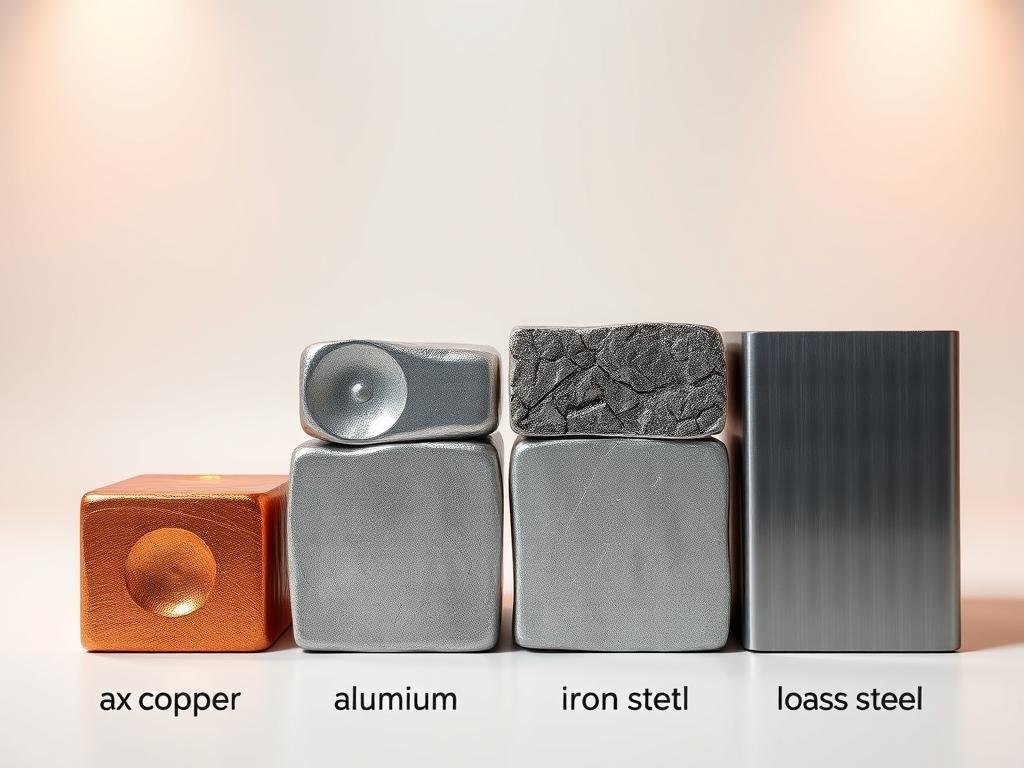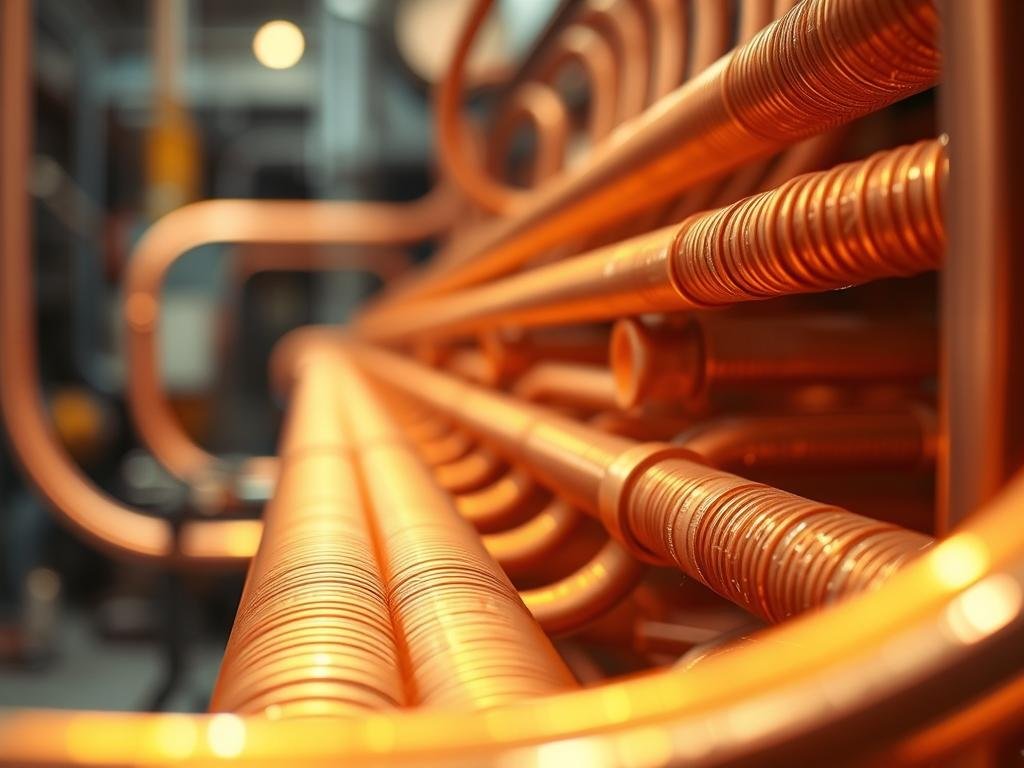Copper is a widely used metal with numerous applications in electrical, plumbing, and construction industries. Its mass density is a fundamental property that determines its suitability for various applications.
The density of copper plays a crucial role in its selection for different uses. Understanding this property provides insights into why copper has been a material of choice for thousands of years.
Copper’s unique combination of properties makes it indispensable in industries ranging from electronics to construction. This article will explore the scientific aspects of copper density and its practical implications in industrial applications.
Understanding Copper and Its Physical Properties
The unique combination of properties in copper makes it an ideal material for numerous applications. Copper (Cu) is a ductile metal with high electrical and thermal conductivity, making it an indispensable material in electrical wiring, plumbing, and various industrial applications.
What Makes Copper Unique Among Metals
Copper possesses a unique combination of physical properties that distinguish it from other metals. Its characteristic reddish-brown color, high electrical conductivity, and excellent thermal conductivity make it a valuable resource. The density of pure copper is a fundamental property that influences its behavior in various applications, contributing to its status as an essential industrial material.
The Atomic Structure Behind Copper’s Properties
Copper’s atomic structure features a filled d-shell with one s-orbital electron, resulting in metallic bonds that are relatively weak compared to metals with incomplete d-shells. This explains its low hardness and high ductility. The relationship between copper’s density and its atomic arrangement provides insights into why this metal exhibits excellent electrical and thermal conductivity properties.
Understanding the fundamental properties of copper, including its density, malleability, and conductivity, helps explain why it has been a metal of choice throughout human history, from ancient tools to modern electronic components.
The Density of Copper: Key Facts and Figures
Copper’s density is a critical property that influences its applications across various industries. Density, defined as mass per unit volume, is a fundamental physical property that determines how much mass is contained in a given volume of a material.
Defining Density in Scientific Terms
Density is calculated by dividing the mass of a substance by its volume, using the formula: density = mass/volume. This property is crucial in understanding the behavior of materials under different conditions.
Standard Density Value of Pure Copper
The density of copper is approximately 8,960 kilograms per cubic meter (kg/m³) at room temperature, which translates to 8.96 grams per cubic centimeter (g/cm³). This value is generally accepted as the standard density for pure copper.
| Property | Value | Unit |
|---|---|---|
| Density of Copper | 8,960 | kg/m³ |
| Density of Copper | 8.96 | g/cm³ |
How Temperature Affects Copper’s Density
Temperature fluctuations can cause thermal expansion or contraction of copper, leading to variations in its density. As copper expands or contracts with temperature changes, its mass remains constant, but its volume changes, affecting its density.
Understanding these variations is crucial for applications where precise density values are required. The density of copper is influenced by factors such as purity level, manufacturing processes, and any treatments it has undergone.
Measuring and Calculating Copper Density
Accurate measurement of copper density is crucial for various industrial and scientific applications. Determining the density of copper involves precise laboratory methods and calculations to ensure reliable results.
Laboratory Methods for Determining Density
Laboratory methods for measuring copper density include traditional techniques and modern instrumentation. One of the classic methods is based on Archimedes’ Principle, which involves immersing a copper sample in water and measuring the volume of water displaced.
Archimedes’ Principle in Practice
When using Archimedes’ Principle, the copper sample is weighed in air and then submerged in water. The difference in weight is used to calculate the volume of the sample, which, combined with its mass, gives the density. Care must be taken to avoid air bubbles and ensure complete submersion.
Modern Measurement Techniques
Modern techniques include digital density meters that use oscillating U-tube technology and X-ray fluorescence (XRF) analyzers. These methods offer rapid and non-destructive density determination, making them suitable for a wide range of applications.
Step-by-Step Density Calculation Process
To calculate the density of copper, one must know its mass and volume. The process involves weighing the copper sample and measuring its volume, either by water displacement or other methods. The density is then calculated using the formula: density = mass / volume.
For example, if a copper sample has a mass of 100 grams and a volume of 11.2 cubic centimeters, the density can be calculated as follows: Convert the mass to kilograms (0.1 kg) and the volume to cubic meters (11.2 × 10⁻⁶ m³). Then, apply the formula to get a density of approximately 8,929 kg/m³, which is close to the standard density of copper.
Comparing Copper Density to Other Common Metals
When evaluating materials for engineering projects, understanding the density of copper in relation to other metals is essential. Copper’s density of 8,960 kg/m³ positions it as a medium-heavy metal among common industrial metals.
Copper is denser than aluminum (2,700 kg/m³) and steel (7,850 kg/m³) but lighter than lead (11,100 kg/m³). This comparison is crucial for selecting the right material for specific applications where weight and density are critical factors.
Density Comparison Chart: Copper vs. Other Metals
| Metal | Density (kg/m³) |
|---|---|
| Copper | 8,960 |
| Aluminum | 2,700 |
| Steel | 7,850 |
| Lead | 11,100 |
| Zinc | 7,140 |
The table above illustrates the density of copper compared to other common metals, highlighting its relative heaviness and the implications for material selection.
Why Copper’s Density Matters in Material Selection
Copper’s known density is a significant factor in its selection for various applications. Its higher density compared to many other structural metals contributes to its stability and vibration-dampening characteristics, making it valuable in precision instruments and audio equipment.
Density-to-Strength Ratio Considerations
When comparing metals for specific applications, the density-to-strength ratio is a crucial consideration. Copper’s density, combined with its mechanical properties, makes it an ideal choice for applications where both strength and conductivity are required.

Copper Alloys and Their Density Variations
Copper alloys exhibit a range of densities based on their composition, making them suitable for diverse applications. When copper is alloyed with other metals like zinc, tin, or aluminum, its density can change. For instance, brass, an alloy of copper and zinc, typically has a lower density compared to pure copper.
Common Copper Alloys and Their Compositions
Copper alloys are formed by combining copper with various elements to achieve specific properties. Some common copper alloys include:
- Brass (Copper-Zinc alloys)
- Bronze (Copper-Tin alloys)
- Aluminum Bronze (Copper with Aluminum)
- Beryllium Copper (Copper with Beryllium)
- Silicon Bronze (Copper with Silicon)
These alloys have different compositions, which affect their densities. For example, brass typically ranges from 8,400-8,600 kg/m³, while bronze generally has a density between 8,700-8,900 kg/m³.
How Alloying Elements Affect Density
The density of copper alloys is influenced by the alloying elements and their atomic masses. Lighter elements like aluminum reduce the overall density, whereas heavier elements can potentially increase it. For instance, beryllium copper shows a notable reduction in density to 8,250-8,400 kg/m³ due to beryllium’s low atomic weight.
The careful control of alloy composition is crucial in industrial applications to achieve specific density targets alongside other desired mechanical and electrical properties.
Industrial Applications Leveraging Copper’s Density
Copper’s high density plays a crucial role in its widespread adoption across various industrial applications. The unique combination of properties in copper, including its density, electrical conductivity, thermal conductivity, and corrosion resistance, makes it a versatile material for numerous uses.
Electrical and Electronic Applications
Copper’s high density is closely related to its excellent electrical conductivity. The dense atomic structure of copper facilitates the free movement of electrons, making it an ideal material for electrical wiring, power transmission, and electronic components. The use of copper in these applications ensures efficient electron flow, which is critical for the performance and reliability of electrical systems.
Thermal Management Systems
In thermal management applications, copper’s high density enables superior heat transfer capabilities. This property makes copper ideal for use in heat exchangers, radiators, cooling systems, and thermal spreaders in electronics and industrial equipment. The dense structure of copper allows for efficient heat dissipation, which is essential for maintaining the performance and longevity of electronic devices and industrial machinery.

Construction and Architectural Uses
The construction industry leverages copper’s density and corrosion resistance for various applications, including plumbing systems, architectural elements, and roofing materials. Copper’s durability and ability to perform under varying environmental conditions make it a preferred choice for these applications. The weight and density of copper contribute to its use in building elements where structural integrity and longevity are essential.
Marine and Corrosion-Resistant Applications
Marine applications particularly benefit from copper’s density and corrosion resistance. The metal is widely used in shipbuilding, underwater equipment, and coastal structures exposed to harsh saltwater environments. Copper’s ability to withstand corrosion in these challenging conditions makes it a valuable material for marine and offshore applications.
| Industry | Application | Benefit of Copper’s Density |
|---|---|---|
| Electrical | Wiring, Power Transmission | Enhanced Electrical Conductivity |
| Thermal Management | Heat Exchangers, Radiators | Superior Heat Transfer |
| Construction | Plumbing, Roofing | Durability, Corrosion Resistance |
| Marine | Shipbuilding, Underwater Equipment | Corrosion Resistance in Harsh Environments |
Conclusion: The Future of Copper in Modern Industry
The significance of copper density extends far beyond its numerical value, influencing the metal’s utility in modern industry. Copper’s mass density of 8,960 kg/m³ is a key characteristic that drives its applications in electrical, thermal, and structural contexts.
As industries evolve, copper density remains a crucial factor in material selection and optimization. The ongoing energy transition and electrification trends are likely to increase demand for copper, with its density playing a crucial role in electrical transmission and renewable energy systems.
The future of copper looks promising, with potential innovations in material science leading to new copper alloys with modified density properties. Copper’s unique combination of density, conductivity, and workability ensures it will remain widely used across multiple industries.
